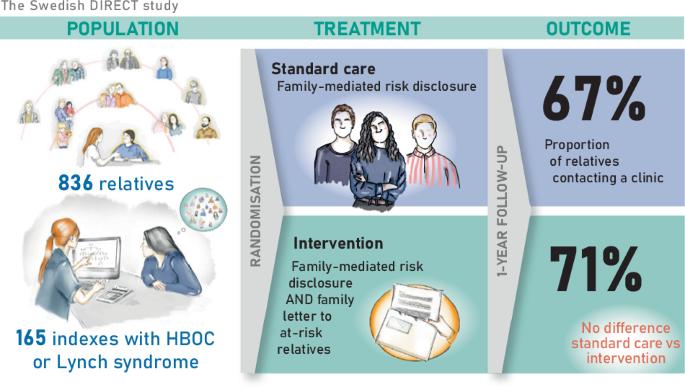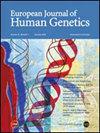直接写信给有遗传性癌症风险的亲属——一项关于医疗辅助与家庭介导风险披露的随机试验。
IF 4.6
2区 生物学
Q2 BIOCHEMISTRY & MOLECULAR BIOLOGY
引用次数: 0
摘要
观察性研究表明,与家庭介导的风险披露相比,医疗机构与高危亲属的直接接触可能会增加遗传咨询(GC)的吸收,但缺乏随机对照试验(RCTs)。本研究评估了与单独的家庭沟通相比,向有遗传性乳腺癌和卵巢癌(HBOC)或Lynch综合征风险的亲属提供直接信函是否会增加GC摄取。在2020年至2023年期间,先证者被随机分配到家庭介导的披露组(对照组)或家庭介导的披露组,并提供直接向有风险的亲属发送信件(干预组)。主要结果是12个月内的GC摄取,以符合条件的高危亲属联系瑞典癌症遗传学诊所的比例来衡量。共有165个家庭(中位数:4个符合条件的亲属,范围:1-26)被随机分为对照组(n = 79)或干预组(n = 86)。对照组GC摄取率67%,干预组71% (P = 0.23)。在调整预定义变量和协变量后,组间仍无显著差异(OR: 1.24, CI: 0.79-1.95, P = 0.34)。远亲摄取量低于一级亲缘(OR: 0.27, CI: 0.18-0.40, P本文章由计算机程序翻译,如有差异,请以英文原文为准。

Direct letters to relatives at risk of hereditary cancer—a randomised trial on healthcare-assisted versus family-mediated risk disclosure
Observational studies suggest that direct contact from healthcare to at-risk relatives may increase genetic counselling (GC) uptake as compared to family-mediated risk disclosure, but randomised controlled trials (RCTs) are lacking. This study assessed whether the offer of direct letters to relatives at risk of hereditary breast and ovarian cancer (HBOC) or Lynch syndrome increases GC uptake compared to family-mediated communication alone. Between 2020 and 2023, probands were randomly assigned to family-mediated disclosure (control) or family-mediated disclosure plus the offer of sending direct letters to at-risk relatives (intervention). The primary outcome was GC uptake within 12 months, measured as the proportion of eligible relatives at risk contacting a Swedish cancer genetics clinic. In total, 165 families (median: 4 eligible relatives, range: 1–26) were randomised to control (n = 79) or intervention (n = 86). GC uptake was 67% in controls and 71% in the intervention group (P = 0.23). After adjusting for predefined variables and covariates, there was still no significant difference between groups (OR: 1.24, CI: 0.79–1.95, P = 0.34). Distant relatives had lower uptake than first-degree relatives (OR: 0.27, CI: 0.18–0.40, P < 0.001), while female relatives had higher uptake than males (OR: 2.17, CI: 1.50–3.12, P < 0.001). This is the largest RCT so far investigating direct letters to relatives. GC uptake was high in both groups, and the intervention of direct letters did not show superiority over family-mediated communication alone. Direct letters to relatives may complement family-mediated disclosure in certain situations, but should not be implemented as a general procedure in cancer genetics practices.
求助全文
通过发布文献求助,成功后即可免费获取论文全文。
去求助
来源期刊

European Journal of Human Genetics
生物-生化与分子生物学
CiteScore
9.90
自引率
5.80%
发文量
216
审稿时长
2 months
期刊介绍:
The European Journal of Human Genetics is the official journal of the European Society of Human Genetics, publishing high-quality, original research papers, short reports and reviews in the rapidly expanding field of human genetics and genomics. It covers molecular, clinical and cytogenetics, interfacing between advanced biomedical research and the clinician, and bridging the great diversity of facilities, resources and viewpoints in the genetics community.
Key areas include:
-Monogenic and multifactorial disorders
-Development and malformation
-Hereditary cancer
-Medical Genomics
-Gene mapping and functional studies
-Genotype-phenotype correlations
-Genetic variation and genome diversity
-Statistical and computational genetics
-Bioinformatics
-Advances in diagnostics
-Therapy and prevention
-Animal models
-Genetic services
-Community genetics
 求助内容:
求助内容: 应助结果提醒方式:
应助结果提醒方式:


